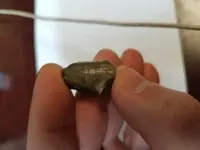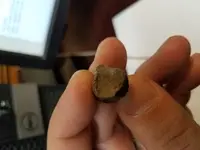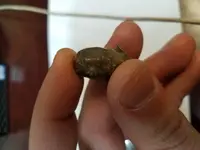can_slaw
Hero Member
I am relatively new to treasure hunting, so I do not have all of the necessary literature yet. I am hopeful someone will be able to pull out their trusted resource manual and help me figure out the most likely match for this little beauty.
Here are the facts that I know about it:
- no rings
- .525 wide is the most "common" measurement i was able to pull from around the face.
- There appears to be a wider portion at the bottom near the base. Because of deformity i cannot measure all of the way around. Best i can find for measurement is .542
- There also appears to be two markings inside the base, one of them looks to be a "5". Looks like possibly "75".
- It came from a Union military hospital site in Wisconsin. It was found by what was later described to me as a former "body parts pit" for the hospital. Apparently they buried the parts after amputations?
Here are the questions that i have:
- What caliber?
- Which side most likely used it?
- Does it look fired, chewed, or perhaps both? If fired I can only assume it was put there with whatever body part it was lodged in!
Any help will be greatly appreciated!!



Here are the facts that I know about it:
- no rings
- .525 wide is the most "common" measurement i was able to pull from around the face.
- There appears to be a wider portion at the bottom near the base. Because of deformity i cannot measure all of the way around. Best i can find for measurement is .542
- There also appears to be two markings inside the base, one of them looks to be a "5". Looks like possibly "75".
- It came from a Union military hospital site in Wisconsin. It was found by what was later described to me as a former "body parts pit" for the hospital. Apparently they buried the parts after amputations?
Here are the questions that i have:
- What caliber?
- Which side most likely used it?
- Does it look fired, chewed, or perhaps both? If fired I can only assume it was put there with whatever body part it was lodged in!
Any help will be greatly appreciated!!









